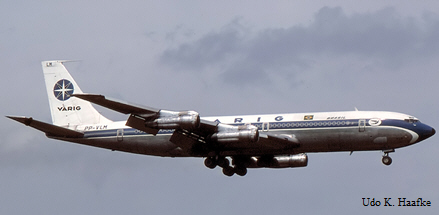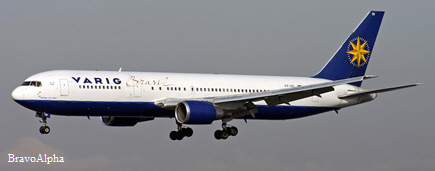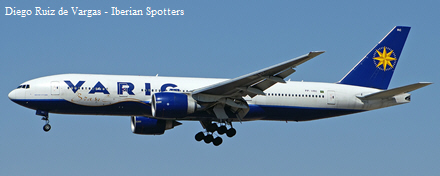Biguá: 1927-1930
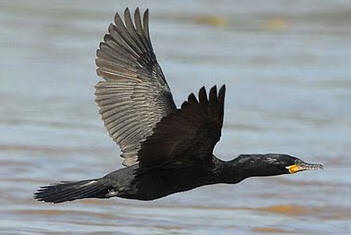

The Biguá (Cormorant) was VARIG’s first logo, but lasted only three
years. Biguá is the largest palmiped bird of Rio Grande do Sul state
and is usually found in lakes as Lagoa dos Patos, where VARIG
made its first route linking Porto Alegre, Pelotas and Rio Grande.
Thus, VARIG’s symbol could be found in the same habitat of its
Dornier seaplanes "Atlântico" and "Gaúcho". VARIG’s aircraft and
cormorants shared the same space, flying and landing on Lagoa dos
Patos.


Cormorant feeds on fish and therefore is an excellent fisherman, being able to stand up to two minutes submerged in water. Just as VARIG’s aircraft, cormorant has "advanced technology" that make them achieves high speeds, releasing all air in their feathers when diving.
Icarus: 1930-1996
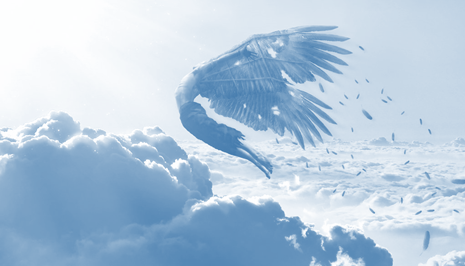
In 1930, Biguá was replaced by Icarus. The Icarus is a famous legend
from Greek mythology. He was Daedalus’s son, a great inventor, who
created wings with beeswax and gull feathers so that he and his son
could escape from Crete island. His father warned his son to not fly
too high, but Icarus was delighted with the opportunity to fly and
will flew increasingly higher, until sun began melt the wax in his
wings. As a result, Icarus fell into the sea.
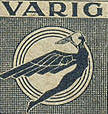





VARIG’s
chose Icarus to represent the human dream of fly. Initially
the logo was circumscribed in three circles with Rio Grande do Sul’s
flag colors (green, yellow and red). Then the circles gone and
Icarus began to carry Brazil’s flag . With the arrival of Super G
Constellation, in 1955, Icarus suffered another change: Brazil’s
flag was removed and Icarus began to stay within a black circle.
In 1961 Icarus was replaced by Compass Rose, but remained
stamped on VARIG’s aircraft fuselage (in the front, next to the
doors) until 1996.
Compass Rose: 1954-2006
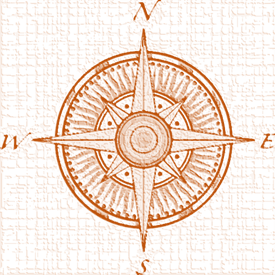
VARIG’s famous Compass
Rose was created by Nelson Jungbluth. He worked at VARIG for 35
years as supervisor in visual ads, flyers, menus and posters.
Although it was created in 1954, the Compass Rose only began to
appear in VARIG’s aircraft fuselage in 1961, after purchase
Real-Aerovias-Nacional airlines. VARIG’s new paint was so beautiful
that lasted over forty years without any changes and was voted as
the most beautiful livery in the world.
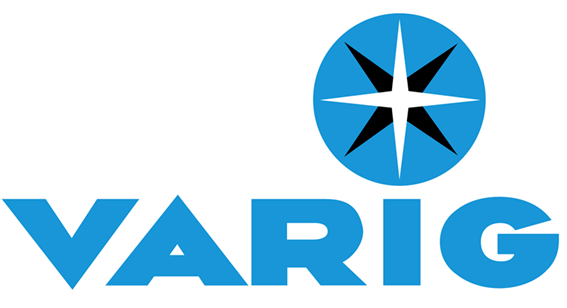
In December 1996, after more than forty years without any changes, VARIG’s visual identity was updated. The rebranding was taken by Landor Associates, who also was responsible for creating a new brand for Rio Sul and Nordeste . The compass rose was restyled with yellow and gold colors, the “Varig” name became dark blue and followed by the “Brasil” characteristic signature.
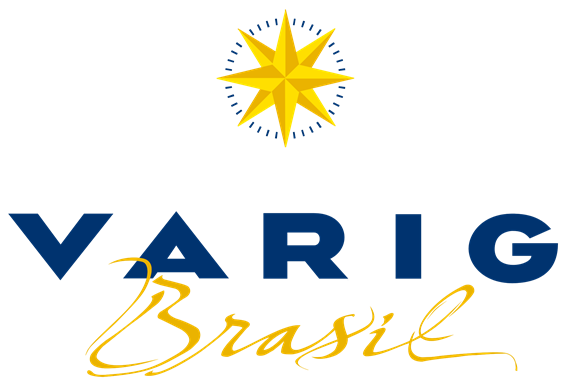
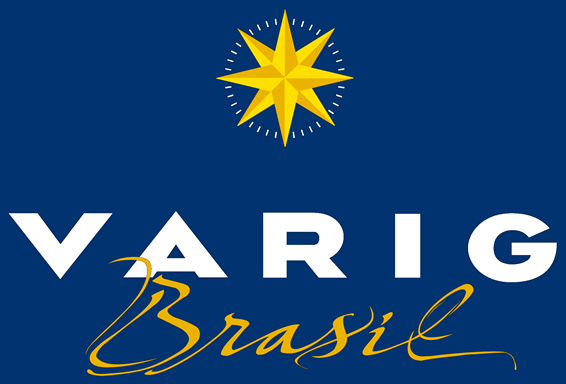
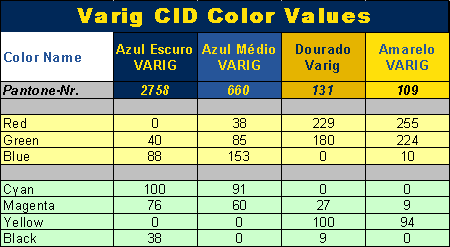
Aircraft's Livery:
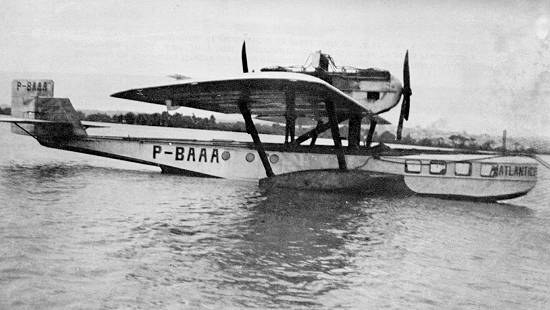
Dornier "Atlântico" - 20s
In 1927 commercial aviation was starting in Brazil. At that time, it was not common to paint the aircraft. VARIG’s first aircraft didn’t received neither the Biguá logo nor the name on the fuselage, only the aircraft’s name and its registration. VARIG’s first aircraft was Dornier Wal, named "Atlântico" and registered as P-BAAA.
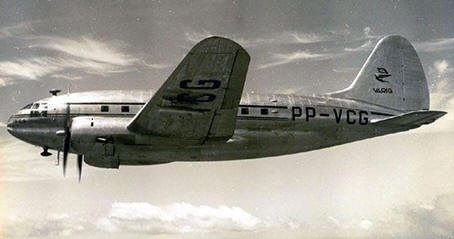
Curtiss C-46 - 40s
VARIG’s
logo was printed for the first time on aircraft’s fuselage in 1931,
with the arrival of Junkers A- 50 aircraft. At this time VARIG’s
logo was the Icarus already. Below Icarus image was also the name
"VARIG" in uppercase. But the biggest highlight on aircraft’s
fuselage remained its baptisms name and its prefix, both written in
huge letters. The name “VARIG” and its logo were, generally,
discreetly located in plane’s tail. In Junkers F-13 aircraft, for
example, in the tail was written the aircraft 's name and VARIG’s
logo was in fuselage’s lateral, in very small size.
The first aircraft to receive Icarus’s new version (without circles
and carrying Brazil’s flag) was the De Havilland DH89A Dragon Rapid,
in 1942. DH89A was also the first aircraft to receive actually a
painting on its fuselage. Now, in besides the prefix and baptismal
name, the aircraft also have a thick black line on fuselage’s sides,
just below the windows. The "nose" was also painted in black.
VARIG’s livery undergone a small change with the arrival of the "Electrinhas"
in 1944. Now instead of one thick line, two thinner lines one above
and other below the windows, and only the top of the "nose" was
painted in black. With the arrival of the Douglas DC-3, one more
modification. Instead of a line below the windows, two lines even
thinner.
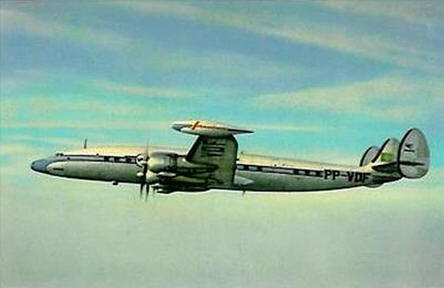
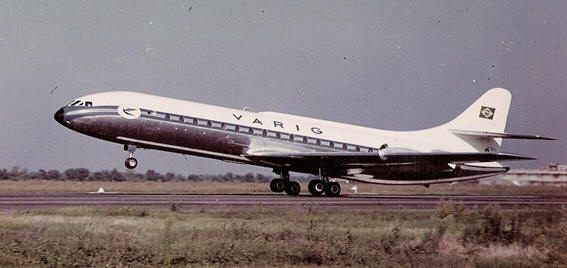
Lockheed Super G Constellation and Caravelle
1 - 50s
VARIG’s livery undergone a major change in 1954/1955, with the arrival of Convair 240 and Lockheed Super G Constellation. Now VARIG became an international airline with flights between Rio de Janeiro and New York, for the first time VARIG’s aircraft won colors. The baptismal name was extinct, but the prefix was kept. The Icarus carrying Brazil’s flag on the tail now is a bit bigger, with the name " VARIG" below. The tail also won Brazil’s color flag. On fuselage’s sides, instead of black lines, a blue belt in the windows with two thin white lines in the middle. The name "VARIG" was also placed just above the blue belt in big letters. Only tip of aircraft’s nose was black. To complete Icarus appeared again, wrapped in a circle on fuselage’s side.
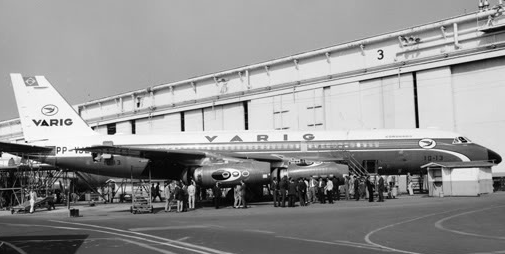
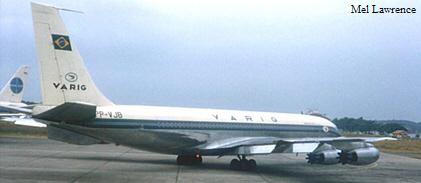
Convair 990 and Boeing 707-400 - 1961
With
the arrival of jets aircraft, in 1959 and 1960, VARIG’s livery
suffered another change. The Icarus now no longer hold Brazil’s flag,
instead was wrapped in a black circle. The aircraft registration was
in smaller letters at the end of the fuselage and right above the
blue belt. The name "VARIG " won a font with thicker letters and was
followed by Brazil’s color flag. The aircraft also had Brazil’s
color flag on the tail. The aircraft’s belly was on natural metal,
giving a bright touch.
The first Boeing 707-400, PP-VJA, had a special paint. The tail had
a blue belt with Icarus in the middle and the word "Boeing 707 " in
black above followed by the word "Inter Continental" in red below.
The engines also won two blue belts, in front and in back.
In 1961, after purchase Real-Aerovias-Nacional airlines, the famous Compass Rose was introduced. The first aircraft to receive it were DC-6, Electra II, Convair 990A and DC-8-33. The first aircraft that arrived directly from factory with the new livery was Boeing 707-300, PP-VJR. Now the Brazil’s flag on the tail and was extinguished and in place of Icarus, was stamped the compass rose. VARIG’s new livery won the title of the best livery in the world.
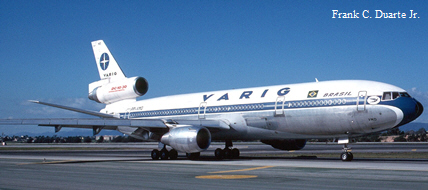
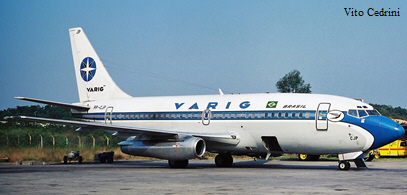
Douglas DC-10 and Boeing 737-200 - 70s
In 1974, with the arrival of the first wide-body DC -10 and Boeing 737-200, VARIG introduced the word "Brasil" next to Brazil’s flag on fuselage sides. Some aircraft had red accents. The DC-10-30 had the word "DC-10- 30" written in red on the tail, below and the word "Intercontinental" just below also in red. The Boeing 737- 200ADV, had the word "737-200 Super Advanced" in red on fuselage’s sides. All -cargo aircraft were identified by the word "CARGO" written in red upper-case next to the name “VARIG” name on fuselage sides. It was also in the 70s that VARIG’s livery also won a simpler variant, instead the natural metal belly, the aircraft could be painted in light gray.
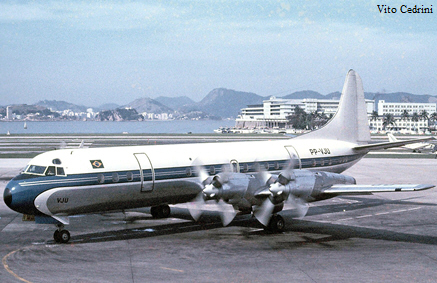
In 70s VARIG’s Electra II became the
only aircraft to operate “Air Bridge” Rio de Janeiro - São Paulo
route. However VARIG was not the only airline to operate the
route. So part of the Electras do not have the compass rose and
the name "VARIG" written on the fuselage.
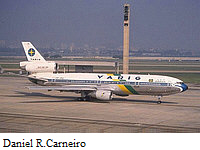
The Douglas DC -10-30 was the first
aircraft to gain a special livery, made in 1994 to the World Cup.
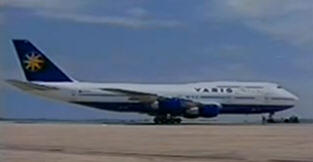
First aircraft to receive new livery,
december 1996.
In December 1996, a Boeing 747-300 was the first aircraft to present VARIG’s new visual identity. Now in a darker blue, yellow and gold compass rose and the signature "Brasil” next to the name "VARIG ". New livery have belly, engines and tail in dark blue. The name “VARIG” on the tail was extinguished and Brazil’s flag on fuselage sides went to the back, next to aircraft’s prefix, in much smaller size.
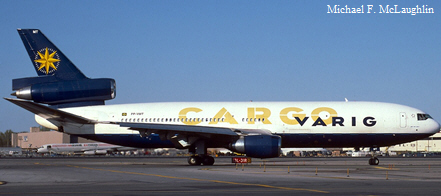
VARIG Cargo also introduced a new livery.
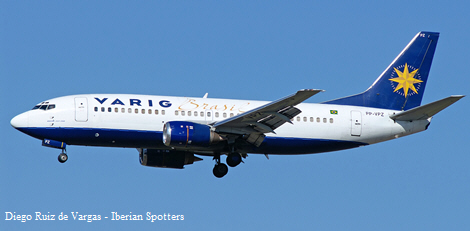
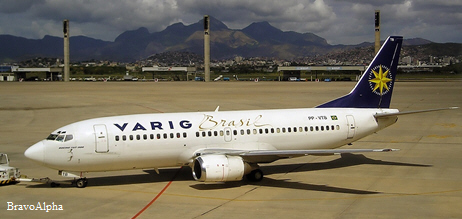
Over time, the livery received some
variations like "white belly" and white and engines version.
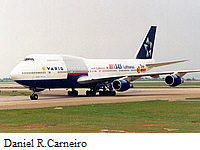
In 1997 Varig became part of Star
Alliance and a Boeing 747-300 was painted with a special livery. In
1998, a Boeing 767- 200ER also received this same special livery.
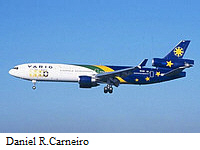
In the World Cup 1998, a MD -11 and
Boeing 737-300 won a special painting.
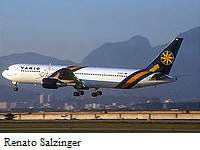
In 2000, to commemorate Brazil’s 500th
anniversary, a Boeing 767- 300ER received a special livery.
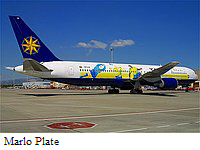
In the World Cup 2002, a Boeing 767-
200ER and Boeing 737-300 aircraft received a special livery.
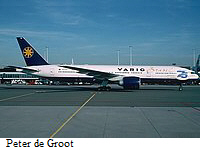
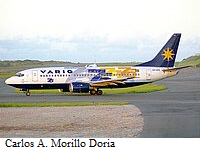
In May 2002, one Boeing 777-200 and one
Boeing 737-300 received a special livery in celebration for VARIG’s
75 years old.
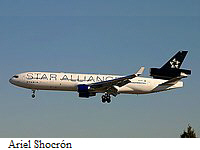
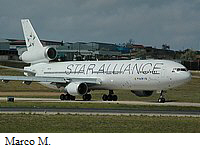
In 2004, an MD-11 received the Star
Alliance livery. Later, another MD-11 earned a the complete white
Star Alliance livery. A Boeing 767-300ER also won the all white
version.
In 2003/2004, after VARIG’s merger with Rio Sul and Nordeste, the livery was once again modified. Now the name "VARIG " was on giant letters stamped on fuselage sides and “Brasil” signature went down. There was also a slight change in the line that divides the white part from the blue belly. Before there was a light and dark blue strip dividing the two sides, now there is only a light blue gross line and with a space for the “Brasil” signature.
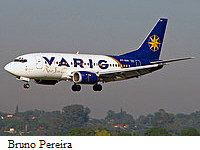
In 2003 there was an experimental livery
on Rio Sul’s Boeing 737-500. The idea was to keep Rio Sul brand as a
low cost, low fare subsidiary, but it was dropped.
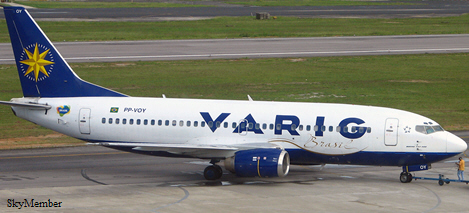
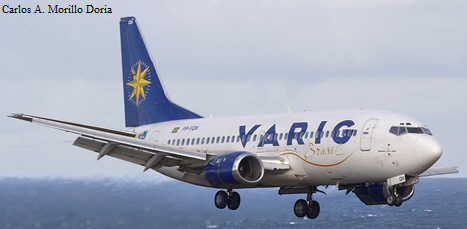
Like the previous livery, it was the
“white belly" and “white belly and engines” version.
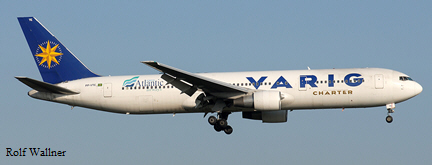
In 2004, after Rotatur’s end, VARIG
launched "VARIG Charter" in partnership with Euro Atlantic airways.
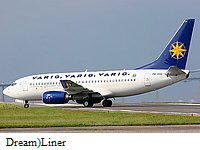
In 2004 was also released a special
paint in Boeing 737-700, PR-SAG, about the traditional jingle
"Varig, Varig, Varig".
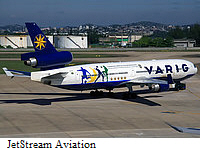
In World Cup 2006, a MD-11 and Boeing
737-300 received a special livery. That was the last VARIG’s special
livery.



